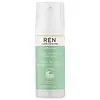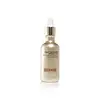What's inside
What's inside
 Key Ingredients
Key Ingredients

 Benefits
Benefits

 Concerns
Concerns

 Ingredients Side-by-side
Ingredients Side-by-side

Water
Skin ConditioningCetearyl Alcohol
EmollientCamellia Oleifera Seed Oil
Skin ConditioningCetearyl Ethylhexanoate
EmollientMyristyl Myristate
EmollientSesamum Indicum Seed Oil
EmollientGlycerin
HumectantButyrospermum Parkii Butter
Skin ConditioningCaprylic/Capric Triglyceride
MaskingTriheptanoin
Skin ConditioningCetearyl Glucoside
EmulsifyingMyristyl Laurate
Oryzanol
Skin ConditioningHelianthus Annuus Seed Oil
EmollientEthylhexylglycerin
Skin ConditioningVaccinium Macrocarpon Seed Oil
Skin ConditioningBisabolol
MaskingRibes Nigrum Seed Oil
EmollientCarbomer
Emulsion StabilisingHippophae Rhamnoides Fruit Extract
Skin ConditioningCitrus Nobilis Peel Oil
MaskingTocopherol
AntioxidantAnthemis Nobilis Flower Oil
MaskingCinnamomum Camphora Linalooliferum Leaf Oil
PerfumingPelargonium Graveolens Flower Oil
MaskingPhenoxyethanol
PreservativeSodium Dehydroacetate
PreservativePueraria Lobata Symbiosome Extract
AntioxidantLaminaria Ochroleuca Extract
Skin ConditioningCassia Alata Leaf Extract
AstringentCalendula Officinalis Flower Extract
MaskingGlucose
HumectantParfum
MaskingRosmarinus Officinalis Leaf Extract
AntimicrobialLactic Acid
BufferingSodium Hydroxide
BufferingCitronellol
PerfumingGeraniol
PerfumingLimonene
PerfumingLinalool
PerfumingWater, Cetearyl Alcohol, Camellia Oleifera Seed Oil, Cetearyl Ethylhexanoate, Myristyl Myristate, Sesamum Indicum Seed Oil, Glycerin, Butyrospermum Parkii Butter, Caprylic/Capric Triglyceride, Triheptanoin, Cetearyl Glucoside, Myristyl Laurate, Oryzanol, Helianthus Annuus Seed Oil, Ethylhexylglycerin, Vaccinium Macrocarpon Seed Oil, Bisabolol, Ribes Nigrum Seed Oil, Carbomer, Hippophae Rhamnoides Fruit Extract, Citrus Nobilis Peel Oil, Tocopherol, Anthemis Nobilis Flower Oil, Cinnamomum Camphora Linalooliferum Leaf Oil, Pelargonium Graveolens Flower Oil, Phenoxyethanol, Sodium Dehydroacetate, Pueraria Lobata Symbiosome Extract, Laminaria Ochroleuca Extract, Cassia Alata Leaf Extract, Calendula Officinalis Flower Extract, Glucose, Parfum, Rosmarinus Officinalis Leaf Extract, Lactic Acid, Sodium Hydroxide, Citronellol, Geraniol, Limonene, Linalool
Water
Skin ConditioningCaprylic/Capric Triglyceride
MaskingButylene Glycol
HumectantGlycerin
HumectantIsododecane
EmollientDimethicone
EmollientIsostearyl Isostearate
EmollientNiacinamide
SmoothingPolymethylsilsesquioxane
Neopentyl Glycol Diheptanoate
EmollientPolyglyceryl-6 Polyhydroxystearate
EmulsifyingPolyglyceryl-6 Polyricinoleate
EmulsifyingMagnesium Sulfate
Sodium Chloride
MaskingParachlorella Beijerinckii Exopolysaccharides
Skin ProtectingPhloretin
AntioxidantFucus Spiralis Extract
EmollientTetraselmis Chui Extract
EmollientSpiraea Ulmaria Extract
AstringentHydrolyzed Algin
Sorbitan Oleate Decylglucoside Crosspolymer
CleansingDisteardimonium Hectorite
StabilisingPolyglycerin-6
HumectantXanthan Gum
EmulsifyingTriethyl Citrate
MaskingLavandula Angustifolia Extract
Skin ConditioningEucalyptus Globulus Leaf Extract
PerfumingBergamot/Grapefruit/Orange/Tangerine Fruit Ferment Extract
AntioxidantMica
Cosmetic ColorantCitrus Limon Fruit Extract
MaskingEthylhexylglycerin
Skin ConditioningTriethoxycaprylylsilane
Phenoxyethanol
PreservativeCI 77891
Cosmetic ColorantWater, Caprylic/Capric Triglyceride, Butylene Glycol, Glycerin, Isododecane, Dimethicone, Isostearyl Isostearate, Niacinamide, Polymethylsilsesquioxane, Neopentyl Glycol Diheptanoate, Polyglyceryl-6 Polyhydroxystearate, Polyglyceryl-6 Polyricinoleate, Magnesium Sulfate, Sodium Chloride, Parachlorella Beijerinckii Exopolysaccharides, Phloretin, Fucus Spiralis Extract, Tetraselmis Chui Extract, Spiraea Ulmaria Extract, Hydrolyzed Algin, Sorbitan Oleate Decylglucoside Crosspolymer, Disteardimonium Hectorite, Polyglycerin-6, Xanthan Gum, Triethyl Citrate, Lavandula Angustifolia Extract, Eucalyptus Globulus Leaf Extract, Bergamot/Grapefruit/Orange/Tangerine Fruit Ferment Extract, Mica, Citrus Limon Fruit Extract, Ethylhexylglycerin, Triethoxycaprylylsilane, Phenoxyethanol, CI 77891
 Reviews
Reviews

Ingredients Explained
These ingredients are found in both products.
Ingredients higher up in an ingredient list are typically present in a larger amount.
This ingredient is an emollient, solvent, and texture enhancer. It is considered a skin-softener by helping the skin prevent moisture loss.
It helps thicken a product's formula and makes it easier to spread by dissolving clumping compounds.
Caprylic Triglyceride is made by combining glycerin with coconut oil, forming a clear liquid.
While there is an assumption Caprylic Triglyceride can clog pores due to it being derived from coconut oil, there is no research supporting this.
Learn more about Caprylic/Capric TriglycerideEthylhexylglycerin (we can't pronounce this either) is commonly used as a preservative and skin softener. It is derived from glyceryl.
You might see Ethylhexylglycerin often paired with other preservatives such as phenoxyethanol. Ethylhexylglycerin has been found to increase the effectiveness of these other preservatives.
Glycerin is already naturally found in your skin. It helps moisturize and protect your skin.
A study from 2016 found glycerin to be more effective as a humectant than AHAs and hyaluronic acid.
As a humectant, it helps the skin stay hydrated by pulling moisture to your skin. The low molecular weight of glycerin allows it to pull moisture into the deeper layers of your skin.
Hydrated skin improves your skin barrier; Your skin barrier helps protect against irritants and bacteria.
Glycerin has also been found to have antimicrobial and antiviral properties. Due to these properties, glycerin is often used in wound and burn treatments.
In cosmetics, glycerin is usually derived from plants such as soybean or palm. However, it can also be sourced from animals, such as tallow or animal fat.
This ingredient is organic, colorless, odorless, and non-toxic.
Glycerin is the name for this ingredient in American English. British English uses Glycerol/Glycerine.
Learn more about GlycerinPhenoxyethanol is a preservative that has germicide, antimicrobial, and aromatic properties. Studies show that phenoxyethanol can prevent microbial growth. By itself, it has a scent that is similar to that of a rose.
It's often used in formulations along with Caprylyl Glycol to preserve the shelf life of products.
Water. It's the most common cosmetic ingredient of all. You'll usually see it at the top of ingredient lists, meaning that it makes up the largest part of the product.
So why is it so popular? Water most often acts as a solvent - this means that it helps dissolve other ingredients into the formulation.
You'll also recognize water as that liquid we all need to stay alive. If you see this, drink a glass of water. Stay hydrated!
Learn more about Water